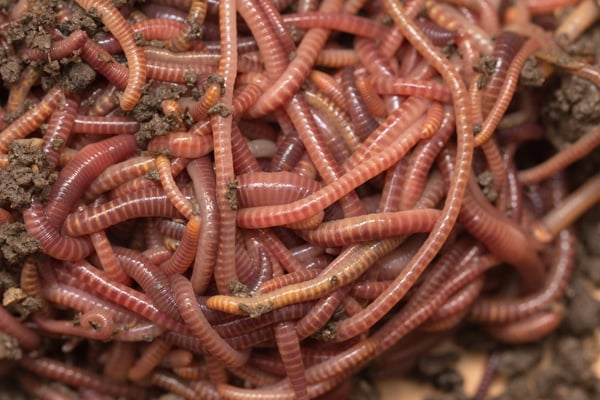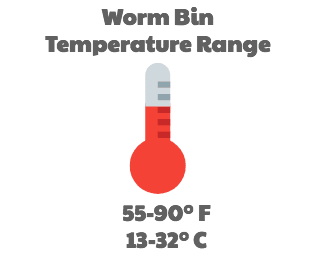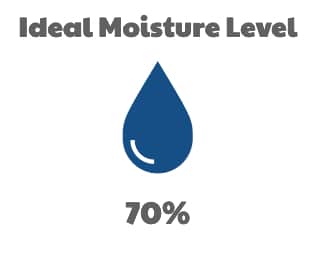How To Add Red Wigglers To Garden Box
This guide will introduce you to the red wiggler to include a deeper on dive on the species and information on breeding, life cycle, and reproduction. We'll talk about how to maintain red wigglers and why they should be the go-to worm for most composters.
Introduction to the Red Wiggler: Anatomy, Reproduction, and Life Cycle
 The red wiggler (binomial name:eisenia fetida) is the world's most common composting worm.
The red wiggler (binomial name:eisenia fetida) is the world's most common composting worm.
As a member of the epigeic – Latin for "on the earth" – class of composting worms, red wigglers generally will not be found in soil. Rather, they thrive in and under leaf litter, manure, decomposing vegetation, and other organic matter.
Native to Europe, eisenia fetida are not classified as invasive species in North America as they are not considered to have a negative environmental impact in the wild.
Red wigglers are less commonly referred to as tiger worms, brandling worms, manure worms, panfish worms, and trout worms.
This species features a vibrant color with yellow banding and is closely related to the more uniformly-pigmented eisenia andrei.
A study suggests that the two can produce hybrid offspring, a phenomenon which should otherwise be considered impossible between most worm species.
Fun fact: The "fetid" part of the binomial name refers to what some say is a foul-smelling secretion the red wiggler uses to fend off predators. But I've been dealing with them for years and never noticed this!
Anatomy and Digestive Tract of a Red Wiggler
The anatomy of a red wiggler resembles that of other common earthworms; a long-segmented body begins at the pointed head and terminates at a slightly-flatted tail.
A fleshy band called a clitellum features prominently on the body of the red wiggler at roughly 1/3rd of the length of the worm.
The digestive tract is simple, starting at the mouth where the worm begins to consume its food before passing it on to the pharynx.
 The pharynx is a muscular section which acts like a pump to pull food into the mouth before pumping it out into the esophagus.
The pharynx is a muscular section which acts like a pump to pull food into the mouth before pumping it out into the esophagus.
The esophagus is narrow and thin-walled and acts as the "waiting room" for the gizzard.
The gizzard is the area where the food gets crushed and ground down before moving on.
Note: This need for grinding is why grit is recommended in a worm bin. The worm features no native grinding capability so the worm relies on ingested grit to help grind its food in the gizzard.
The stomach is where the first chemical breakdown of food happens with the help of a protein-busting enzyme. Calciferous glands in the stomach also serve to neutralize acidic foods passing through the worm's digestive tract.
The intestine forms the longest part of the worm and is where the majority of digestion takes place via enymatic processes.
The castings eventually pass through the anus at the end of the worm as capsules coated with a biologically-rich mucus. (You're not eating I hope.)
Why Red Wigglers Are the King of Composting Worms
 The mighty red wiggler may be used as a bait worm for smaller fish or as a protein source for chickens and reptiles.
The mighty red wiggler may be used as a bait worm for smaller fish or as a protein source for chickens and reptiles.
But its main use is for – of course – vermicomposting.
And as mentioned above, they are the most common composting worm in the world.
But why?
Well there's probably not just one reason.
Rather, a combination of cost, hardiness, and comfort in a wide range of temperatures makes it the most appropriate composting worm for most new vermicomposters
Hardiness and Temperature Tolerance
 Red wigglers are a resilient composting worm, tolerant of a wider range of temperature than other species. For instance, its larger cousin, the European Nightcrawler prefers cooler temperatures in the high-60°F range. African Nightcrawlers, on the other hand, prefer warmer temperatures between 77°F and 86°F.
Red wigglers are a resilient composting worm, tolerant of a wider range of temperature than other species. For instance, its larger cousin, the European Nightcrawler prefers cooler temperatures in the high-60°F range. African Nightcrawlers, on the other hand, prefer warmer temperatures between 77°F and 86°F.
The red wiggler can tolerate both the low and high ends of these ranges, reproducing and processing organic waste well between 55°F-90°F.
Its cocoons are famously hardy as well, able to withstand prolonged freezing temperatures, staying viable in a suspended state until they are able to hatch in warmer weather.
Cost
 Thanks to its adaptability to different climates and ability to reproduce quickly in them, the cost of red wigglers is consistently lower than European nightcrawlers and significantly lower than the African nightcrawler.
Thanks to its adaptability to different climates and ability to reproduce quickly in them, the cost of red wigglers is consistently lower than European nightcrawlers and significantly lower than the African nightcrawler.
But red wigglers are nobody's idea of cheap, and the skyrocketing demand for all things garden-related due to the COVID pandemic of 2020 boosted prices of all composting worms.
Maintaining a Worm Bin with Red Wigglers: Temperature, Moisture, and pH
I call these the "Big 3" factors of worm bin maintenance. If you keep all 3 within appropriate ranges, then there's not *that* much that can go wrong with your bin.
Temperature
 As mentioned earlier, red wigglers have a wide temperature tolerance. For best results, keep a temperature of 55°F-90°F.
As mentioned earlier, red wigglers have a wide temperature tolerance. For best results, keep a temperature of 55°F-90°F.
Short departures out of that temperature range are fine.
While the ambient air outside of the bin certainly has an effect, what really matters is the temperatureinside the bin. The worm and microbe activity in the bin will generate heat so you can expect a worm bin to be 10-20 degrees warmer in the winter.
The thermal mass of a large worm bin will also feature more protection against short-term temperature swings, so if you've got the option of keeping a large worm bin vs a small one, choose large every time!
Moisture
 Moisture in the worm bin is the most-underrated factor in worm bin success and again, red wigglers don't prefer it any warmer or drier than any other composting worm.
Moisture in the worm bin is the most-underrated factor in worm bin success and again, red wigglers don't prefer it any warmer or drier than any other composting worm.
Please take this next statement to heart.
Most worm bin owners run their worm bins way too wet. And a properly-maintained worm bin should not be producing leachate.
Because so much water is bound us within the cells of fruit and vegetables, it doesn'tseem like your feedings are adding that much water. But they are.
To be conservative, I would add bedding every feeding. This prevents a mucky, muddy vermicompost that will be simply difficult to harvest at best, and a stinky, anaerobic mess at worst.
For best results, you want to shoot for about 70% moisture level. The simplest test for this is to squeeze a handful as hard as you can.
At the perfect moisture levels – which is about 70% – that handful should barely yield one drop of liquid.
The articles below make the case for running a drier worm bin and how to precisely measure the water content of your worm bin or compost bin.
How To Add Red Wigglers To Garden Box
Source: https://urbanwormcompany.com/guide-to-red-wigglers-eisenia-fetida-composting-worm/
Posted by: raylichannoosee.blogspot.com

0 Response to "How To Add Red Wigglers To Garden Box"
Post a Comment